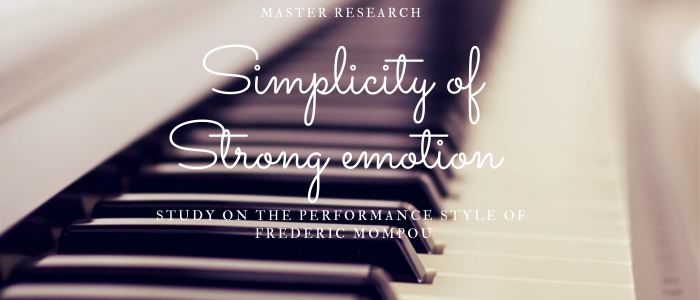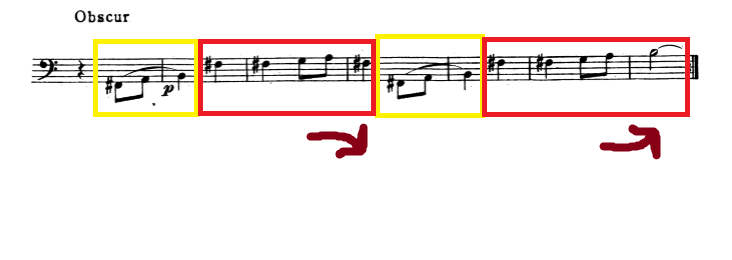1. Abstract
3. Oeuvre
4. Influences
7. Analysis of Cants Màgics
7.1. Enèrgic
7.2. Obscur
7.3. Profond-lent
7.5. Calma
An obscure and solemn theme opens the second movement of Cants Màgics. Although at first sight it seems like a clear example of monody, one realizes by listening to Mompou’s recording that it is an interaction between two melodic motifs. This is due to the resonances that can be heard thanks to the damper pedal or finger-pedaling. The last note of each intervention is kept for a while as the other voice enters. For this reason, I deduce that this opening is played with two hands, one for each voice. I have done a scheme that helps to visualize this.
It is worth analyzing the timing and dynamics of these voices. Every time he plays a motive he does it differently. As it is difficult to show this on the annotated score, I will pursue to describe it with words.
- Melodic motif 1 (1st time): quite regular rhythm. Slightly rushed between A-B. Small accent on the B.
- Melodic motif 1 (2nd time): softer dynamics than the first appearance of voice 1. Slightly rushed between A-B again. No accent on B.
- Melodic motif 1 (3rd time): F# is played with a tenuto, that means a little longer than its written duration. A-B are played a tempo. B is the softest note as if it was the ending note of a slur.
- Melodic motif 1 (4th time): the notes are played in a steady tempo. They are all equal in dynamics. All the notes are kept after being played. This makes the passage dissonant.
- Melodic motif 2 (1st statement): the first F# has a slight accent and the second F# is the consequence of it. Quavers are rushed to the last F#. This last F# has an accent.
- Melodic motif 2 (1st question): the first and the second F# are played similarly. The quavers are steady.
- Melodic motif 2 (2nd statement): the first F# is played softer than before. The second F# is played with an impulse.
- Melodic motif 2 (2nd question): the first F# has an accent. The second F# is a consequence of it and it is elongated. The rest of the passage is steady and does not present any accentuated notes.
Once having analyzed the beginning of the opening, I proceed to comment on the following section, which is presented in the same structure.
The recording of Mompou shows the same tendency to fluctuate with the tempo as in the first line of the movement. However, this time much more accentuated.
Section B contrasts with section A in almost all senses. The only common point is the literal voice 2 of
section A on the left hand. Its indication is brilliant and double movement (twice as fast as before).
Meanwhile, the right-hand presents fast consecutive fourths in forte that seem to yell at the audience. As the main melody finishes it follows a declining passage. It loses its intensity and consistency with harmonies. For example, fourths become sixths. Tempo slows down and Mompou writes perdentse (getting lost).
The recording analysis of this section demonstrates a tendency of Mompou to reinforce notes by making a short pause before they take place, even if they present a slur. This is very uncommon among pianists in the 21st century. As the music loses its energy Mompou does not allow these short moments of rest to happen. Music and silence become then two faces of the same coin (Mompou’s philosophy like Música Callada - silent music).
Moving on to the last section of the piece we find the Clar from section A indicated as Tempo I. It is the exact same phrase as in the first page of the movement. An element should be noted in Mompou’s approach to this reappearance of the phrase. Unlike before, he uses something called dislocations, also widely referred to as asynchronisation. It was a common pianistic practice of the 19th and first half of the 20th centuries which consisted of playing one hand slightly after the other in vertically aligned notes to enhance the beauty and poignancy of some notes. Often the melody was retarded and the accompaniment kept stable.

